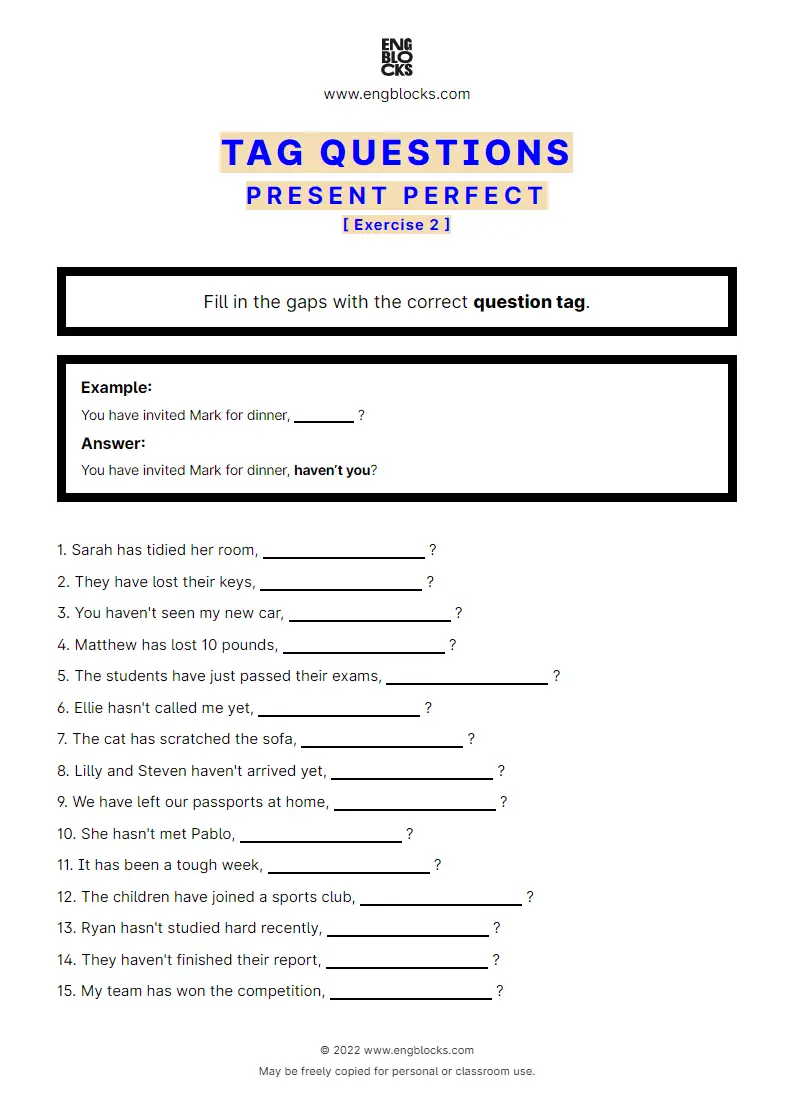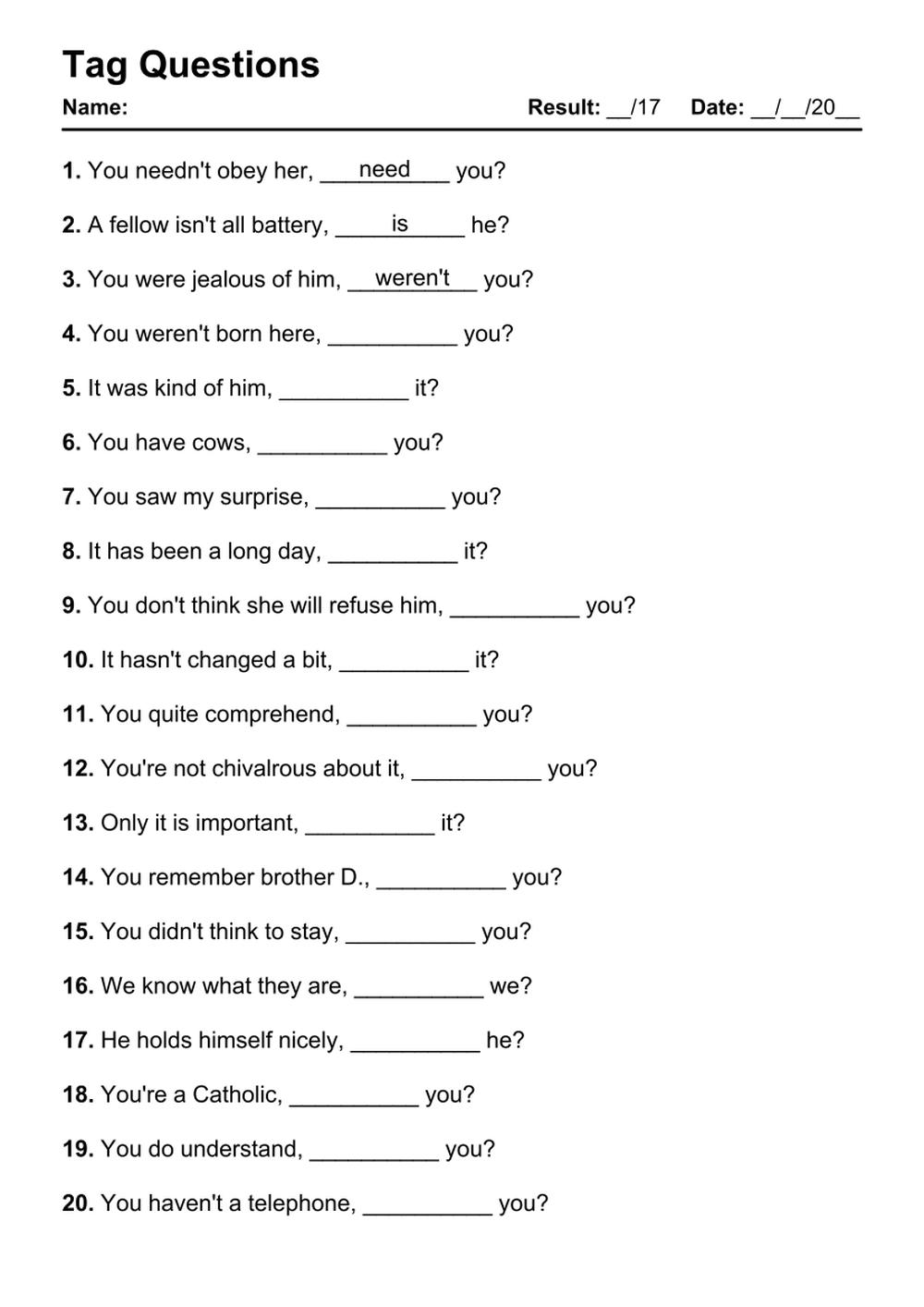
Mastering Conversational Nuance: The Power of Grammar Worksheets: Tag Questions
English grammar is a vast and intricate landscape, full of nuances that can delight and challenge learners alike. Among its many fascinating structures, tag questions stand out as a particularly common and useful element of everyday conversation. They are short questions added to the end of a statement, transforming it into an inquiry, seeking confirmation, or inviting agreement. While seemingly simple, mastering tag questions requires a solid understanding of their formation, agreement rules, and the subtle shifts in meaning conveyed by intonation. This is precisely where dedicated Grammar Worksheets: Tag Questions become an indispensable tool for learners at all levels.
What Exactly Are Tag Questions?

At their core, tag questions are mini-questions appended to declarative statements. They typically consist of an auxiliary verb (or a form of ‘to be’) and a pronoun, mirroring the subject of the main statement.

For example:

- "It’s a beautiful day, isn’t it?"
- "You haven’t finished your homework, have you?"
- "She can speak French, can’t she?"


The primary function of a tag question is to invite a response or to confirm information. They are highly conversational and are used extensively in spoken English to make statements less assertive, to check understanding, or to encourage interaction.
The Fundamental Rules of Formation

Understanding the basic rules for forming tag questions is crucial. The general principle is one of inversion and polarity:
-
Positive Statement, Negative Tag: If the main statement is positive, the tag question is usually negative.

- You are happy, aren’t you?
- They went to the party, didn’t they?
- He will come, won’t he?

-
Negative Statement, Positive Tag: Conversely, if the main statement is negative, the tag question is positive.
- She isn’t coming, is she?
- We haven’t met before, have we?
- They couldn’t help, could they?
-
Auxiliary Verb Agreement: The auxiliary verb in the tag question must match the auxiliary verb (or the main verb if it’s ‘be’ or a modal) used in the main statement.
- You have seen that movie, haven’t you? (Auxiliary ‘have’)
- She is studying, isn’t she? (Verb ‘be’)
- They can swim, can’t they? (Modal ‘can’)
-
Pronoun Agreement: The pronoun in the tag question must correspond to the subject of the main statement. If the subject is a noun, it is replaced by an appropriate pronoun (he, she, it, they, we, you, I).
- Sarah is a doctor, isn’t she?
- The dogs are barking, aren’t they?
- That car is fast, isn’t it?
-
Tense Consistency: The tense of the auxiliary verb in the tag question must match the tense of the main verb in the statement.
- He works hard, doesn’t he? (Simple Present)
- They were playing, weren’t they? (Past Continuous)
- She had finished, hadn’t she? (Past Perfect)

Special Cases and Exceptions
While the basic rules cover most scenarios, English wouldn’t be English without a few exceptions and special cases that often trip up learners. These are prime areas where focused Grammar Worksheets: Tag Questions can provide invaluable targeted practice.
-
"I am" statements: The tag for "I am" is always "aren’t I?" This is a common and important exception.
- I am late, aren’t I? (Not "amn’t I?")
-
"Let’s" statements: When a statement begins with "Let’s" (meaning "Let us"), the tag is "shall we?"
- Let’s go to the park, shall we?
-
Imperative statements (commands/requests): For commands or requests, the tag is usually "will you?" or "won’t you?"
- Close the door, will you?
- Don’t forget, will you?
-
Statements with "there is/are": The subject in the tag question reflects "there."
- There’s a problem, isn’t there?
- There aren’t any tickets left, are there?
-
Indefinite pronouns as subjects:
- Someone, somebody, everyone, everybody, no one, nobody: These typically take the pronoun "they" in the tag.
- Someone called, didn’t they?
- Nobody was home, were they?
- Nothing, everything, something, anything: These take "it" in the tag.
- Nothing happened, did it?
- Everything is ready, isn’t it?
- Someone, somebody, everyone, everybody, no one, nobody: These typically take the pronoun "they" in the tag.
-
Statements with negative words: If the main statement contains a word that makes it negative in meaning (e.g., never, hardly, rarely, seldom, scarcely, few, little), the tag question is positive.
- She rarely goes out, does she?
- He has few friends, does he?
- You’ve hardly eaten anything, have you?
-
Statements with "have": The tag depends on whether "have" is used as a main verb (possession) or an auxiliary verb.
- You have a car, don’t you? (Main verb, ‘do’ auxiliary used)
- You have finished, haven’t you? (Auxiliary verb)
- He has to work, doesn’t he? (Main verb, ‘do’ auxiliary used)
Intonation and Meaning
Beyond the grammatical structure, the intonation used when speaking a tag question significantly alters its meaning. This subtle aspect is harder to capture in written Grammar Worksheets: Tag Questions, but it’s vital for real-world communication.
-
Rising Intonation: If your voice rises at the end of the tag question, it indicates a genuine question. You are unsure and truly seeking information or confirmation.
- You’re coming, aren’t you? (Is it true? Please tell me.)
-
Falling Intonation: If your voice falls at the end of the tag question, it suggests you are expecting agreement or simply making a statement that you believe to be true, seeking confirmation rather than new information. It’s more of a rhetorical device or a way to include the listener.
- It’s a lovely day, isn’t it? (I think it’s a lovely day, and I expect you to agree.)
Understanding this distinction is key to using tag questions effectively and naturally.
Why Are Tag Questions Important for English Learners?
Tag questions are not just grammatical curiosities; they are integral to fluent and natural English conversation.
- Encouraging Interaction: They invite the listener to participate in the conversation.
- Softening Statements: They can make a direct statement sound less confrontational or more polite.
- Checking Understanding: They allow speakers to confirm that their message has been received or understood correctly.
- Expressing Opinion and Seeking Agreement: They are a common way to state an opinion and subtly ask for the listener’s concurrence.
- Building Rapport: Using them correctly demonstrates a higher level of conversational fluency and can help build rapport with native speakers.
The Indispensable Role of Grammar Worksheets: Tag Questions
While theoretical knowledge of rules is fundamental, true mastery of tag questions comes through consistent and varied practice. This is precisely where Grammar Worksheets: Tag Questions become an indispensable tool for learners and educators alike.
How Worksheets Help:
- Reinforcement of Rules: Worksheets provide repetitive exposure to the rules of formation, solidifying them in the learner’s mind. Seeing various examples and applying the rules repeatedly helps learners internalize the patterns.
- Practice with Different Tenses and Structures: Good worksheets will present tag questions across various tenses (present, past, future, perfect, continuous) and with different types of statements (positive, negative, imperative, ‘let’s’), ensuring comprehensive practice.
- Identification of Common Errors: By attempting exercises, learners will naturally encounter situations where they might make mistakes (e.g., "I am, amn’t I?"). Worksheets, especially those with answer keys, allow for immediate self-correction and understanding of where their knowledge gaps lie.
- Building Confidence: Successfully completing exercises builds confidence in using tag questions in real conversation. This confidence is crucial for moving from passive understanding to active application.
- Variety of Exercise Formats: Effective Grammar Worksheets: Tag Questions offer diverse exercise types:
- Fill-in-the-blanks: Providing the statement and asking learners to complete the tag.
- Matching: Matching statements to their correct tag questions.
- Error Correction: Identifying and correcting incorrect tag questions in given sentences.
- Sentence Transformation: Changing a statement into a statement with a tag question.
- Dialogue Completion: Integrating tag questions into conversational snippets to practice their contextual use.
- Creating Sentences: Asking learners to generate their own sentences using specific tag questions or based on given scenarios.
Benefits for Teachers and Self-Learners:
- For Teachers: Worksheets provide structured activities for classroom practice, homework assignments, and assessment. They save preparation time and offer a clear framework for teaching this specific grammar point.
- For Self-Learners: Worksheets offer a systematic way to learn and practice independently. With answer keys, self-learners can track their progress and identify areas needing more attention. Online platforms and printable PDFs have made high-quality Grammar Worksheets: Tag Questions more accessible than ever.
Creating Effective Worksheets
When designing or choosing Grammar Worksheets: Tag Questions, consider these points for maximum effectiveness:
- Clear Instructions: Ensure the instructions for each exercise are unambiguous.
- Gradual Difficulty: Start with simpler exercises covering basic rules and gradually introduce more complex cases and exceptions.
- Contextual Relevance: Where possible, use sentences and scenarios that are relevant and interesting to the learners, reflecting real-life communication.
- Ample Examples: Provide clear examples for each new rule or exception introduced.
- Answer Key: An answer key is vital for self-correction and immediate feedback.
- Variety: Mix up exercise types to keep learners engaged and to target different learning styles.
Conclusion
Tag questions, though small, are mighty. They add a layer of naturalness, politeness, and conversational depth to spoken English, making communication smoother and more engaging. Mastering their formation and nuanced usage is a significant step towards achieving fluency. And the journey to mastering them is significantly aided by dedicated practice, particularly through the strategic use of comprehensive Grammar Worksheets: Tag Questions. They provide the structured repetition and varied scenarios necessary to solidify understanding, build confidence, and ultimately empower learners to use these conversational gems with ease and accuracy in their daily interactions. So, if you’re looking to polish your conversational English, diving into some well-designed tag question worksheets is an excellent place to start, wouldn’t you agree?
